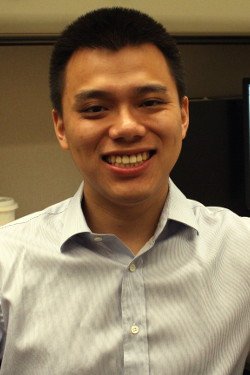Kuang Yu
2016 Regional Award Finalist — Post-Doc

Current Position:
Research Scientist
Institution:
D. E. Shaw Research (Previously at Princeton University)
Discipline:
Theoretical Chemistry

Current Position:
Research Scientist
Institution:
D. E. Shaw Research (Previously at Princeton University)
Discipline:
Theoretical Chemistry
Recognized for: Singular contributions to the fundamental understanding of disordered solid materials and development of novel computational methods
Areas of Research Interest and Expertise: Ab initio based force field development, Multi-scale electronic structure methods, First-principles simulations on semiconductors
Biography:
PhD, Chemistry, University of Wisconsin
BS, Chemistry, Peking University, China
BS, Statistics, Peking University, China
Dr. Yu’s work focuses on computational studies of solid materials. He earned his PhD at the University of Wisconsin - Madison, where he developed highly accurate ab initio force fields to study gas adsorption processes in metal organic frameworks.
Dr. Yu’s work contributes to the development of quantum embedding theory, which allows scientists to combine different levels of quantum mechanical methods to describe localized phenomena embedded in extended environments. This method has been used to study problems such as point defects in inorganic semiconductors and heterogeneous catalysis processes on metal surfaces at much higher accuracy.
Dr. Yu also develops mathematical models to understand the order-disorder phase transition within Cu2ZnSnS4 (CZTS), a promising candidate for photovoltaic solar cells. High temperature-induced lattice disorder in CZTS was simulated for the first time and the associated band fluctuation was quantified. Dr. Yu employs the model to compute the compositional phase diagram of CZTS, quantifying the stoichiometry of the disordered CZTS. These studies contribute to the development of an understanding of the mechanism of voltage loss in CZTS-based photovoltaics and provide theoretical guidance for further improvements.
“My goal is to understand the behaviors of molecules and solid materials using fundamental physical principles. In long term, I wish to further boost the predictive power of computer simulations in modern chemistry.”
Key Publications:
Other Honors:
2013 Hirschfelder Student Prize